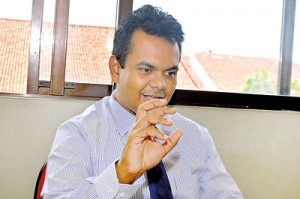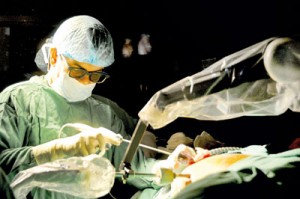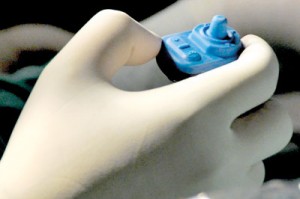News
Robotic arm an asset in urology at J’pura Hospital
View(s):Pioneering laparoscopic surgeon, Dr. Niroshan Seneviratne shows how kidney removal is made easier
The patient is prepped and under general anaesthesia. The urological surgical team of the Sri Jayewardenepura General Hospital, just about to embark on a laparoscopic procedure, is scrubbed up and ready.
There, however, is something in the Operating Theatre (OT) that the Sunday Times team in gowns, masks and caps spots immediately.

Consultant Urologist and Transplant Surgeon Dr. Niroshan Seneviratne
Having been in numerous OTs in numerous hospitals, both state and private before, something unique and different catches the eye.
Bent over the inert patient, is a robotic arm – a first for Sri Lanka. This has been assisting in urological laparoscopic surgeries for nearly three years.
Yes, the urological surgical team headed by Consultant Urologist and Transplant Surgeon, Dr. Niroshan Seneviratne has been using robotic technology in the form of the single-arm, taking advantage of the rapid technological advances in urology through laparoscopy.
Laparoscopy also known as key-hole surgery is minimally invasive, with only tiny cuts (incisions) being made in the abdomen as compared to open surgery, where there would be a long cut. Through these tiny cuts, a laparoscope with a camera as well as the surgical instruments are inserted to perform the procedure.
At the semi-state Sri Jayewardenepura Hospital, along with a 3-Dimension High-Definition (3-D HD) Laparoscopy System is the single robotic arm, ready to assist Dr. Seneviratne and his team in a nephrectomy – the removal of a diseased kidney.
The arm helps to stabilize the image as otherwise a human assistant who holds the camera can easily become fatigued in a lengthy procedure, while also not responding to the surgeon’s needs with anticipation, points out Dr. Seneviratne, as we see the robotic arm at work.

The robotic arm at the Sri Jayewardenepura Hospital. Pix by Priyantha Wickramaarachchi
The other drawbacks when a human is holding the camera, according to him, could be wandering imagery and magnified-wobbling electronic fields.
Reiterating that the robotic arm gives greater stability of view, he says that another advantage would be less inadvertent smearing of the lens.
Into meticulous detail goes Dr. Seneviratne – complex urological laparoscopic surgeries go on for many hours and fatigue and tiredness can set in quickly. Another factor is that the doctor who is assisting the surgeon should also be equally competent to anticipate what the moves of the senior would be and take the camera there. This is negated by a robotic arm.
However, he cautions that the robotic arm is not for routine procedures but for more complex surgeries such as radical prostatectomy, with prostate cancer being the No. 1 malignancy affecting men across the world. The best results can be obtained from a robotic radical prostatectomy.
Did you know that a radical prostatectomy which is surgery to remove the prostate and some of the surrounding tissue, if the cancer has not spread beyond the prostate gland, gives healthy men at least another 10 years of life, asks Dr. Seneviratne.
The robotic arm in his OT is manipulated by a blue joystick and he points out that it operates on the same principle as when one plays a video game.
Having worked with the robotic arm for the benefit of many a patient, Dr. Seneviratne and his team have a dream: That they could own a full robot, known as the da Vinci system for complex surgery.
The da Vinci system is a combination of computers, electronics and machinery that provides a surgeon with an intuitive tool for seeing and controlling surgical instruments during an operation.

A nephrectomy (removal of a kidney) through laparoscopy being performed by the team headed by Dr. Niroshan Seneviratne with the help of the robotic arm.

The joystick used to manipulate the robotic arm
K.H.
(Please see the cover of MediScene)

